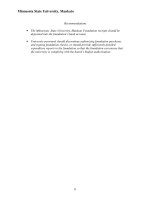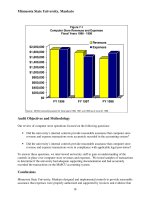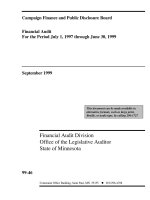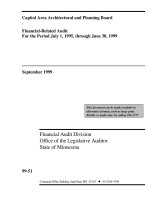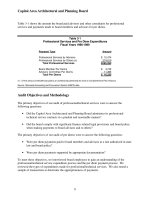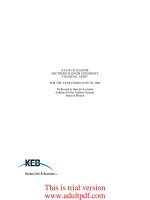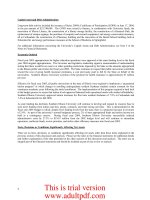Minnesota State University, Mankato Financial Audit For the Period July 1, 1995 through June 30, 1998_part2 pot
Bạn đang xem bản rút gọn của tài liệu. Xem và tải ngay bản đầy đủ của tài liệu tại đây (44.2 KB, 10 trang )
Minnesota State University, Mankato
8
Recommendations
• The Minnesota State University, Mankato Foundation receipts should be
deposited into the foundation’s bank account.
• University personnel should discontinue authorizing foundation purchases
and signing foundation checks, or should provide sufficiently detailed
expenditure reports to the foundation so that the foundation can ensure that
the university is complying with the board’s budget authorization.
Minnesota State University, Mankato
9
Chapter 3. Tuition, Fees, and Room and Board
Chapter Conclusions
Minnesota State University, Mankato’s internal controls provided reasonable
assurance that tuition, fees, and room and board revenue collections were
safeguarded and accurately reported in the accounting records. For the items
tested, the university complied with finance-related legal provisions.
Minnesota State University, Mankato offers undergraduate and graduate programs to resident
and nonresident students. The tuition and fee amount for a resident undergraduate student was
$53.75 per quarter credit in the 1997-1998 school year. The resident graduate tuition rate was
$82.15 per quarter credit in the 1997-1998 school year. Figure 3-1 shows the breakdown
between tuition, fees, and room and board revenue for the audit period.
At the time of the MnSCU merger in 1995, the state universities used their own information
system, Unisys, for recording and maintaining student data, assessing tuition, and monitoring
unpaid balances. This system supported various activities such as registration, financial aid,
billing, and accounts receivable. Each day the business office reconciled the amount of revenue
collected to a daily report generated by Unisys. Financial activity was recorded on MnSCU’s
accounting system through a nightly interface between Unisys and the MnSCU system. The
business office reviewed the interface daily to ensure that all transactions had been recorded
properly. The business office also performed a daily reconciliation of its bank deposits to the
Unisys report.
Figure 3-1
Breakdown Between Tuition, Fees, and Room and Board Revenue
Fiscal Years 1996 - 1998
Graduate
Tuition
9%
Fees
15%
Room & Board
17%
Undergraduate
Tuition
59%
Source: MnSCU accounting system.
Minnesota State University, Mankato
10
Audit Objectives and Methodology
Our review of Minnesota State University, Mankato’s tuition, fees, and room and board revenue
focused on answering the following questions:
• Did Minnesota State University, Mankato’s internal controls provide reasonable
assurance that revenue collections were safeguarded and accurately reported in the
accounting records?
• Did Minnesota State University, Mankato’s internal controls provide reasonable
assurance that revenue collections were in compliance with applicable legal provisions?
To address this objective, we interviewed university employees to gain an understanding of the
controls over billing, collecting, depositing, and recording tuition, fees, and room and board
revenues. We examined the conversion codes used to record Unisys financial activity on the
MnSCU accounting system. We analyzed the amounts of tuition and fees collected to ensure
that they appeared reasonable. Also, we reviewed the access to the Unisys system granted to
university employees. Finally, we reviewed how the university monitored and pursued
collection of its outstanding account receivables.
Conclusions
Minnesota State University, Mankato’s internal controls provided reasonable assurance that
revenue collections were safeguarded and accurately reported in the accounting records. For the
revenue transactions tested, the university complied with applicable legal provisions.
Minnesota State University, Mankato
11
Chapter 4. Employee and Student Payroll
Chapter Conclusions
Minnesota State University, Mankato’s internal controls provided reasonable
assurance that employees and students were accurately paid in accordance with
management’s authorization. Employee payroll expenditures were accurately
reported in the accounting records, except that as mentioned in Chapter 2,
Finding 1, the university did not record the correct occurrence dates for student
payroll transactions. Also, as discussed in Chapter 2, Finding 2, the university
did not adequately restrict access by system office employees to the
personnel/payroll system.
The university complied with material finance-related legal provisions and
bargaining agreements for the transactions tested.
Payroll represents the largest operating cost for Minnesota State University, Mankato. In fiscal
year 1998, the university had payroll expenditures of approximately $67 million.
Minnesota State University, Mankato employed approximately 1,400 full and part-time faculty
and administrators as of May 1999. The university’s employees are covered under the following
compensation plans:
• The Inter Faculty Organization (IFO)
• The Minnesota State University Association of Administrative and Service Faculty
(MSUAASF)
• The Middle Management Association (MMA)
• The Minnesota Association of Professional Employees (MAPE)
• The American Federation of State, County, and Municipal Employees (ASCFME)
• The Minnesota Nurses Association (MNA)
• The Personnel Plan for MnSCU Administrators
During fiscal year 1996, the college used the state’s personnel and payroll system (PPS) and the
State Colleges and Universities Personnel and Payroll System (SCUPPS) to process payroll
information. SCUPPS records different employee classification assignments and faculty
appointments and stores pay rate information. PPS calculated the amounts paid employees and
tracked leave accruals for classified and unclassified employees and excluded administrators. In
June 1996, the college began processing payroll information in the state’s new SEMA4 payroll
system while continuing to use SCUPPS.
Minnesota State University, Mankato’s human resources office enters all new employee data and
makes changes to employee records directly in SCUPPS. It also gathers timesheets from
classified and part-time employees and enters the payroll information into SEMA4. Faculty
Minnesota State University, Mankato
12
payroll does not require separate entries into SEMA4. Instead, the biweekly salary transactions
interfaced from SCUPPS to SEMA4 for producing payroll warrants and ultimately posting
payroll expenditures into MnSCU accounting.
The university also used the SCUPPS leave module to track leave accrual data for faculty and
administrators. In addition, the university maintained its own separate database, which also
tracked leave accruals for its employees.
The university also employs students to perform various jobs throughout the campus. During the
audit scope, Minnesota State University, Mankato paid over $9 million to students from various
funding sources. The university participated in both the federal and state work-study programs.
Minnesota State University, Mankato also employed student workers who were paid from
institutional funds. The university business office entered appointment and tax information into
the Unisys student payroll system. Students completed biweekly timesheets and submitted them
to their supervisors for approval. The business office entered timesheet hours into the student
payroll system that generated the payroll warrants.
Audit Objectives and Methodology
The primary objectives of our review were as follows:
• Did the university design internal controls to provide reasonable assurance that
employees and students were compensated in compliance with applicable legal
provisions and management’s authorization, and that payroll expenditures were
accurately reported in the accounting records?
• Did university payroll expenditures comply with applicable finance-related legal
provisions and related employee bargaining agreements?
To address these objectives, we interviewed university staff to obtain a general understanding of
the internal control structure over the payroll and personnel process, analyzed payroll trend data,
reviewed source documents to determine proper authorizations, and recalculated payroll amounts
to ensure proper payment. We tested a sample of payroll transactions to determine whether the
university complied with applicable legal provisions and related employee bargaining
agreements. We also reviewed the security clearances to the SEMA4 and SCUPPS systems for
Minnesota State University, Mankato data.
Conclusions
Minnesota State University, Mankato’s internal controls provided reasonable assurance that
employees and students were paid appropriately in accordance with management’s authorization.
Employee payroll expenditures were accurately reported in the accounting records, except that as
mentioned in Chapter 2, Finding 1, the university did not record the correct occurrence dates for
student payroll transactions. The university complied with material finance-related legal
provisions and bargaining agreements for the transactions tested. As discussed in Finding 2 in
Chapter 2, we found that the university did not adequately limit computer access relating to
payroll information.
Minnesota State University, Mankato
13
Chapter 5. Operating Expenditures
Chapter Conclusions
Minnesota State University, Mankato designed internal controls to provide
reasonable assurance that operating expenditures were accurately reported in
the accounting records. For the items tested, the university complied with
material finance-related legal provisions. However, the university did not
properly record a betterment (see Finding 1, in Chapter 2) and did not complete
its 1997 fixed asset inventory in a timely manner.
Minnesota State University, Mankato administrative and academic departments initiated
purchase requests directly in the MnSCU Purchase Control System, which encumbered funds.
The Minnesota State University, Mankato purchasing department was responsible for procuring
goods and services, using MnSCU guidelines to solicit bids and select vendors. The purchasing
department obtained informal quotes for items less than $10,000, while purchases in excess of
$25,000 required a sealed bid. Upon receipt of goods, the business office received shipping
documents. The accounts payable clerks matched the documents to the purchase order and the
invoice before processing the payment on the MnSCU accounting system. The business office
also received invoices for services provided and processed those payments on the MnSCU
accounting system. Table 5-1 provides a breakdown of material expenditure categories in fiscal
year 1998.
Table 5-1
Minnesota State University, Mankato
Material Operating Expenditures
Fiscal Year 1998
1998
Supplies and Materials $9,374,498
Equipment 2,029,841
Utilities 2,523,258
Contracted Food Services 2,983,116
Purchased Services 1,246,199
Repairs and Alterations to Buildings 1,174,628
Total $19,331,540
Source: Based on summarization of downloaded expenditure files from the MnSCU accounting system for fiscal year 1998 as of
June 30, 1998. Figures may differ from Table 1-1 due to classifications.
Audit Objectives and Methodology
The primary objectives of our review was to answer the following questions:
Minnesota State University, Mankato
14
• Did the university design internal controls to provide reasonable assurance that it
accurately reported operating expenditures in the accounting records and adequately
safeguarded fixed assets from theft or loss?
• Did the university comply with applicable legal provisions?
To meet these objectives, we interviewed university staff to gain an understanding of the internal
control structure over the purchasing and the payment process for expenditures. We reviewed
and analyzed disbursement data. We also tested a sample of expenditures to determine whether
the university had adequate supporting documentation and authorization, paid the correct
amount, properly recorded the transactions in MnSCU’s accounting system, and complied with
MnSCU purchasing policies. Finally, we reviewed the university's process to record and track
fixed assets.
Conclusions
Minnesota State University, Mankato designed internal controls to provide reasonable
assurance that operating expenditures were accurately reported in the accounting records.
For the items tested, the university complied with applicable legal provisions and
management's authorization. However, the university did not properly record a
betterment (See Finding 1 in Chapter 2) and did not complete its 1997 inventory in a
timely manner as discussed in Finding 4.
4. Minnesota State University, Mankato did not complete a fixed asset inventory in a
timely manner.
Minnesota State University, Mankato did not complete a physical inventory of fixed assets in a
timely manner. As of May 14, 1999, the university had not located the missing equipment or
adjusted its accounting records for the results of an inventory that began for the summer of 1997
and where the majority of the work was done in fiscal year 1998. That inventory noted 239
equipment inventory items with an original cost of $752,000 that were reported missing by
Inventory Stores. The university continued to work on locating the missing items in 1999. The
university adjusted the inventory records for $584,000 in missing inventory in July 1999.
Minnesota State University, Mankato tracks incoming equipment and maintains a current
equipment listing. Inventory Stores completes a physical equipment inventory once every two
years.
The university should resolve missing equipment and adjust accounting records in a timely
manner. Prompt follow up would result in a more efficient and effective process to increase the
likelihood of locating the missing assets. Without an adjustment, equipment inventory is
overstated on the financial statements by the amount of missing equipment because fixed assets
are valued at historical cost for financial reporting.
Recommendation
• The university should complete its periodic inventory and adjust accounting
records in a timely manner.
Minnesota State University, Mankato
15
Chapter 6. Financial Aid
Chapter Conclusions
Minnesota State University, Mankato designed and implemented internal
controls to provide reasonable assurance that it managed state and federal
student financial aid programs in compliance with specific program
requirements. For the items tested, the university complied with federal student
financial aid requirements over cash management and federal reporting.
Minnesota State University, Mankato participated in several student federal financial aid
programs administered by the U.S. Department of Education and the state grant program
administered by the Minnesota Higher Education Services Office. Table 6-1 summarizes federal
financial aid program expenditures for fiscal year 1998.
Table 6-1
Federal Financial Aid Expenditures
Fiscal Year 1998
CFDA
Number Program
Total
Expenditures
84.032 Federal Family Education Loan (FFEL) $17,126,226
84.063 Federal Pell Grant 4,004,227
84.033 Federal Work-Study (FWS) 543,184
84.007 Federal Supplemental Education Opportunity
Grant (SEOG)
416,590
84.038 Federal Perkins Loan 989,114
Source: June 30, 1998, FISAP and Minnesota State University, Mankato accounting records.
The Federal Pell grant is considered the first source of assistance to eligible students. Eligibility
for the grant is based on the cost of education, the family's ability to pay, and the number of
credits a student is enrolled for. All eligible students receive Pell grants since the funding is not
limited to the available funds at the university. The maximum Pell grant for the 1997-98
academic school year was $3,000 per student.
The Federal Family Education Loan (FFEL) program includes Subsidized and Unsubsidized
Stafford Loans. The student borrower applies for the loan from a private lender. The school
certifies the promissory note for qualifying students. The federal government guarantees the
loan in case of default or cancellation. Approximately 99 percent of the loan proceeds are
electronically deposited to the university's financial aid account. The federal government pays
the interest to the private lender on Subsidized Stafford Loans while the student is in school and
during certain deferment periods. For Unsubsidized Stafford Loans, the interest accrues from the
Minnesota State University, Mankato
16
date of origination and is the responsibility of the borrower. The borrower's grade level and the
amount previously borrowed determine the maximum loan amount.
The Federal Perkins Loan Program provides low-interest loans to needy students. The university
acts as a lender, using both federal funds and a state match for capital contribution. The
university performs loan collection duties, including correspondence with students entering
repayment status, receiving loan repayments, and pursuing delinquent loans. The university
collected $1,136,296 in Perkins principal and interest repayments during the 1997-98 academic
school year.
The Federal Work-Study Program and Federal Supplemental Educational Opportunity Grant are
additional sources of federal financial aid. The federal government’s share must not exceed 75
percent of the total expenditures in the Federal Supplemental Educational Opportunity Grant
Program and the Federal Work-Study Program. The state contributes 25 percent of the funding
for the two programs.
Minnesota State University, Mankato also participates in the Minnesota State Grant Program
funded by the Minnesota Higher Education Services Office (HESO). HESO determines
eligibility for the state grant program and advances funds to the university for disbursement. The
university packages and disburses the state grants along with federal financial aid. During the
1997-98 academic school year, the university disbursed $3,345,514 in state grant funds to
eligible students.
Audit Objectives and Methodology
The primary objectives of our audit were to answer the following questions related to the federal
financial aid programs:
• Did the university design and implement internal controls to provide reasonable
assurance that it properly recorded student financial aid transactions in the accounting
system and administered student financial aid in accordance with applicable federal
regulations?
• Did the university comply with applicable legal requirements for cash management and
federal reporting of student financial aid activity?
To meet these objectives, we evaluated and tested controls over compliance for determining
student eligibility and packaging, awarding, and disbursing state and federal financial aid funds.
We also reviewed and tested compliance with federal regulations for managing federal cash and
reporting federal expenditures.
Conclusions
Minnesota State University, Mankato designed and implemented internal controls to provide
reasonable assurance that it managed state and federal student financial aid programs in
compliance with specific program requirements. The university recorded its financial aid
activity on MnSCU timely and accurately. For the items tested, the university complied with
federal student financial aid requirements over cash management and federal reporting.
Minnesota State University, Mankato
17
Chapter 7. Computer Store Operations
Chapter Conclusions
Minnesota State University, Mankato’s internal controls provided reasonable
assurance that computer store expenses were properly authorized and supported
by invoices and evidence that equipment was received. However, the
university’s internal controls did not provide reasonable assurance that
computer store revenue and disbursement transactions were accurately
recorded in the accounting system. As discussed in Chapter 2, Finding 1, the
university did not record the correct occurrence dates for some computer store
expenditures. In addition, the university did not design adequate controls over
the safeguarding of receipts and the recording of revenue transactions. Finally,
the university did not establish adequate controls over computer store inventory.
Minnesota State University, Mankato operates a computer store through which academic
departments, staff, and students can purchase computers, peripherals, equipment, and supplies.
The computer store is part of the Academic Affairs Department. At the beginning of each year,
the computer store manager sets up open purchase orders in the MnSCU purchasing system. The
business office receives invoices and processes payments to vendors. Store receipts are recorded
on the computer store software package, Point of Sale Inventory System (POSIM). The
computer store only accepts checks and credit cards. Students paying with cash must go to the
business office and bring a paid receipt back to the store. At the end of the day, the store
manager brings checks and credit card slips to the cashiers in the business office for processing.
Computer store operations are accounted for in the Enterprise Fund.
The university hired a private CPA firm to perform procedures on selected accounting records
and transactions of the computer store as of June 30, 1997. The procedures related to the
effectiveness of the internal controls over financial reporting for computer store operations. The
report recommended certain changes in procedures and enhancements to inventory controls.
The university prepares an income statement that includes operating expenses such as payroll,
rent, supplies, and other indirect costs and accounts for cost of goods sold.
As of March 31, 1999, the computer store had a deficit of $23,842. The university’s business
school reviewed computer store operations and made recommendations on how to make the store
financially viable. Figure 7-1 shows the revenues and expenses during our audit period.

